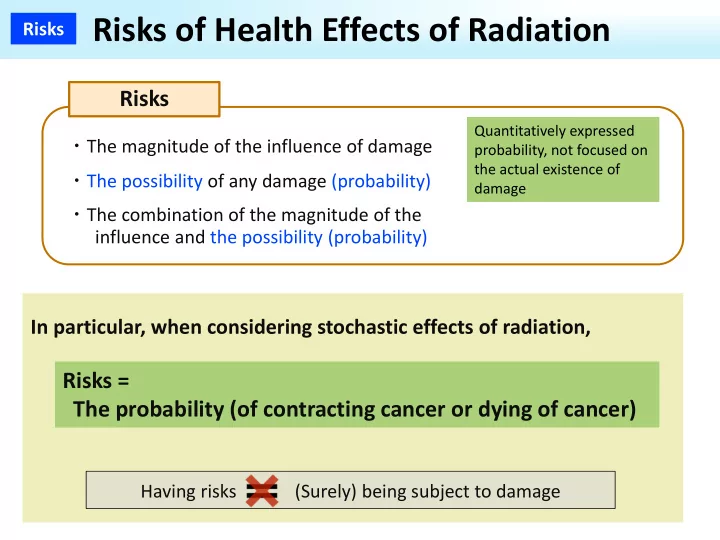

Risks of Health Effects of Radiation Risks Risks Quantitatively expressed Quantitatively expressed ・ The magnitude of the influence of damage probability, not focused on probability, not focused on the actual existence of the actual existence of ・ The possibility of any damage (probability) damage damage ・ The combination of the magnitude of the influence and the possibility (probability) In particular, when considering stochastic effects of radiation, Risks = Risks = The probability (of contracting cancer or dying of cancer) The probability (of contracting cancer or dying of cancer) Having risks (Surely) being subject to damage
Relative Risks and Attributable Risks Risks Incidence Factors Total Yes No Exposed group A B A+B Non‐exposed group C D C+D How many times factor exposure would increase the incidence of an individual: Relative risk larger than 1 Incidence risk among an A represents that risks have exposed group A+B increased due to factor exposure. Relative risk = = The value obtained by subtracting Incidence risk among C 1 from the relative risk is an a non‐exposed group C+D excess relative risk, showing an increased amount of risks. How many times factor exposure would increase the incidence rate of a group: Incidence risk among an Incidence risk among a Attributable risk = ― exposed group non‐exposed group A C = ― A+B C+D
Risks of Cancer Death from Low‐Dose Exposure Risks 1 % 0.5%? 1.5% Approx. 30% Increase in radiation‐induced cancer death (Estimates in the 2007 International Commission on Radiological Protection (ICRP) Recommendations) Percentages of cancer deaths Cancer caused by the lifestyle of each Meal Other individual causes While causes of each cancer have not been identified, meals, smoking habits, Smoking viruses, bactericidal infection, etc. are considered to have some relevance. 0 % 0 100 200 300 Cumulative radiation doses (mSv)
Factors Associated with Carcinogenesis Risks ヒトの死因 Cardiac Factors associated with human cancer Disorders Brain disorders Radiation and ultraviolet rays: 2.0% Medicine: 1.0% Infectious Environmental pollution: 2.0% Salt/food additives and other diseases contaminants: 1.0% Socioeconomic conditions: 3.0% etc. Alcohol: 3.0% Procreative factors: 3.0% Smoking: Perinatal period/growth: 5.0% 30.0% Cancer family history: 5.0% Cancer Occupational environments: 5.0% Infection: 5.0‐10.0% Diets in adulthood and obesity: 30.0% Lack of exercise: 5.0% Source: Prepared based on Cancer Causes Control 1996.7.S55‐S58
Risks of Cancer (Radiation) Risks Relative risks of cancer* Radiation doses (mSv) 1,000 〜 2,000 1.8 [estimated to be 1.5 times per 1,000 mSv] 500 〜 1,000 1.4 200 〜 500 1.19 100 〜 200 1.08 Less than 100 Difficult to detect Source: Website of the National Cancer Center Japan * Risks of developing radiation‐induced cancer are based on the data (solid cancers only) obtained from the analysis of instantaneous exposure due to the atomic bombing in Hiroshima and Nagasaki, and are not based on the observation of long‐term exposure effects. * Relative risks indicate how many times larger the cancer risks are among people exposed to radiation when assuming the risks among non‐ exposed people as 1.
Risks of Cancer (Life Habits) Risks Lifestyle factors Relative risks of cancer 1.6 Smokers 1.6 Heavy drinking (450 g or more/week)* Heavy drinking 1.4 (300 to 449 g or more/week)* 1.22 Obese (BMI ≧ 30) 1.29 Underweight (BMI<19) 1.15 〜 1.19 Lack of exercise 1.11 〜 1.15 High‐salt foods 1.06 Lack of vegetable intake 1.02 〜 1.03 Passive smoking (nonsmoking females) * Alcohol consumption is in ethanol equivalent. Source: Website of the National Cancer Center Japan
Recommend
More recommend